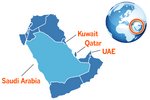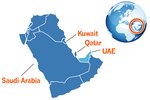Feast In the Middle East: Eating Out in Qatar
By: Nicholas Sawarna
 During our week in Qatar, we explored the various culinary offerings of Doha, the capital city. The Middle East is known for its love of lamb, and in Qatari cuisine, the meat is used to create especially juicy kebabs. The best kebabs, which are smothered in rich, creamy sauces, or packed into pitas, along with vegetables and hummus, are found in the Souq Waqif, Doha's traditional Arab market. Each Arab restaurant offers a wide variety of hummus dishes, whether on its own or mixed with vegetable and meat ingredients. My favourite hummus dish was one mixed with ground lamb, ground beef, and small crisp cubes of fat which melted in your mouth. When smeared on a slice of pita, the concoction tasted divine. Approximately one-fifth of Qatar's population hails from India, so there is no shortage of restaurants serving Indian cuisine. As a lover of curry, I found this deliciously good news. On our third night, I ate a mouth-watering lamb curry. The lamb had absorbed the sauce like a sponge. It was the perfect curried dish. If you are not adventurous enough to stray too far from your usual Western diet, simply head to a mall or The Pearl, Doha's upcoming high-end shopping district. At The Pearl, we had dinner at Carluccio's, a UK-based chain restaurant. I ordered an exceptionally meaty pasta, while my colleagues, Elaine Ng and Tim Ziegler, ordered a triumphant lasagna. The lasagna was as big as my head and had been baked in a thick casing of cheese. Cutting into the lasagna revealed a gorgeous core of tomato and lamb sauce, which oozed out at the corners. The lasagna at Carluccio's is reason enough for someone to want to live in Doha. Fast Food in QatarIf you are looking for fast food, Qatar has you covered. This is evident by the expanding waistlines you see on the street and the numerous diabetes education campaigns visible in malls and other public areas. For example, the food court at the City Centre Mall in Doha has all the necessities of what has become known as the North American diet. To your left, Subway is written in Arabic; in front of you stands a McDonald's; and to your immediate right, both Colonel Sanders and the Burger King smile upon you. Since the chain is known to set the standard of fast food around the globe, I decided to approach McDonald's. I was surprised to find items no longer available in Canada on their menu, including the Cheeseburger Royale and the Big Tasty. Also, their prices are lower than I expected (just US$4.39 for a Big Mac Meal). I decided to go for the McArabia. Geared to the local palate, the McArabia consists of two grilled chicken breasts on a pita topped with fresh tomato slices and diced lettuce. But in order not to make it too healthy (heaven forbid), the concoction is smothered in various creamy sauces. The McArabia is a tasteful novelty, but I still prefer my Big Mac. Domestic Qatari fast food consists mainly of kebab and shawarma, which is usually grilled in front of you and costs next to nothing (e.g., US$2.75 for two kebabs). Unlike the kebabs in higher-end Arab restaurants, which are served on a bed of rice, street kebabs are wrapped in pitas. If you decide to go domestic: watch your place in line; and, if you hesitate when ordering, you risk being pushed out of the queue. The Coffee Culture of QatarQatar also has a prominent coffee bar culture. At the traditional Middle Eastern coffee bars you can still order a cappuccino, but the more adventurous type chooses something stronger. I chose Turkish coffee. Turkish coffee came to the Arabian Peninsula with the Ottoman Empire, which held influence over the Middle East until its collapse at the culmination of the First World War. Noted for its strong flavour and prominent caffeine kick, Turkish coffee is not for amateurs. Having visited the Middle East before and previously tried it, I thought I could handle its bite. I asked our waiter for the strongest concoction they could brew. It came to my table in a small brass decanter accompanied with an espresso-sized cup. The coffee oozed out of the decanter like wet sand and, before tasting it, I waited for the coffee grounds to settle. The taste overwhelmed my senses and the coffee stuck to my teeth and to the sides of my mouth. Immediately I felt uncomfortably awake. With my heart pounding, my head clouded and my brow sweating, I engaged my companions in fast conversation about controversial topics. For those who do not care for coffee, Turkish or other, why not try shisha? The pastime of smoking shisha came to the Middle East via India sometime during the 16th century, and despite periodic bans, has become a common scene in Middle Eastern coffeehouses. I tried shisha when travelling to Iran as a student, and the process is more or less the same throughout the Middle East. Tobacco is the standard product smoked in shisha, but other non-tobacco herb products may be substituted. It is worth noting that although smoking these alternative herb products is still harmful, they do not have the addictive qualities of tobacco. Coffeehouses serving shisha are easily recognizable by a collection of large waterpipes. A waterpipe consists of a perpendicular glass tube with a small metal bowl attached to its top. The bottom of the tube is submerged in a bowl of water to which hoses are attached. A man, called a fireboy, packs heaping wads of sticky flavoured tobacco or herb product into the metal bowl, over which he piles red-hot coals. Then, he gives you a sanitized mouthpiece which is connected to one of the hoses. You are ready for shisha. Inhaled through the mouth, the smoke travels from the hot coals, through the tobacco or herb product, down the glass tube, through the water, and exits by the hose into the mouthpiece held between your lips. The smoke, which has been cooled by the water, tastes like a lightly flavoured summer breeze. You feel lightheaded. Relaxed. The best way to pass an afternoon. Most Popular |
Related |
Copyright (C) 2025 Helen Ziegler and Associates. All rights reserved.







